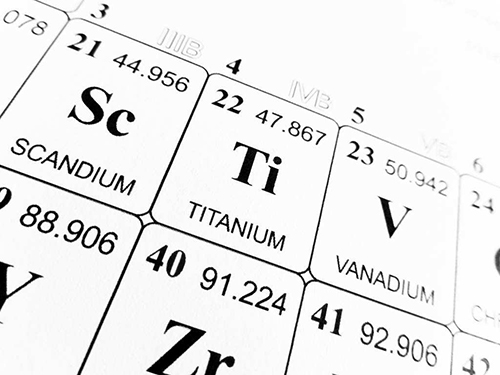Effect of alloying elements on microstructure and properties of titanium alloy
1.Al aluminum has significant solid solution strengthening effect, the solid solubility in α-Ti is greater than the solid solubility in β-Ti, the temperature of α / mutual transformation is increased, and the β α phase region is enlarged, which belongs to α stabilization. element. When the mass fraction of Al in the alloy is 7%, the strength of the alloy increases and the plasticity does not decrease significantly with the increase of Al content. When the mass fraction of Al in the alloy exceeds 7%, brittle Ti3Al appears in the alloy structure, plasticity Significantly lower.
2.V(Mo, Nb, Ta) Vanadium belongs to the β-Ti isomorphous element and has a β-stabilization effect. It is infinitely solid-solved in β-Ti and has a certain solid solubility in α-Ti. Vanadium has a remarkable solid solution strengthening effect, which can maintain good plasticity while improving alloy strengthening. Vanadium also improves the thermal stability of titanium alloys.
3.Cu Copper is a β-stabilizing element. Part of copper in titanium alloy exists in a solid solution state, and another part forms a Ti2Cu or TiCu2 compound. TiCu2 has thermal stability and acts to improve the thermal strengthening property of the alloy. Since the solid solubility of copper in the α phase is significantly reduced as the temperature is lowered, the strength of the alloy can be improved by ageing precipitation strengthening.
4.Si silicon has a higher eutectoid transformation temperature (860 ° C), which can improve the heat resistance of the alloy. The amount of silicon added to the heat resistant alloy is preferably not more than the maximum solid solubility of the α phase, and is generally about 0.25%. Due to the large difference in atomic size between silicon and titanium, it is easy to segregate at dislocations in the solid solution, preventing dislocation motion, thereby improving heat resistance. In addition to solid solution in the matrix as a solid solution element, a part of the second phase precipitates and precipitates, which enlarges the temperature range in which martensite is stable and increases the hardness of the alloy. For the directional solidification growth of titanium aluminum alloy, the addition of a small amount of silicon can improve the creep resistance and oxidation resistance of the solidified structure, but reduce the fracture toughness.
5.Zr, Sn Neutral elements have large solubility in both α-Ti and β-Ti, which complement and strengthen. In the heat resistant alloy, in order to ensure that the alloy structure is based on the α phase, in addition to aluminum, zirconium and tin are added to further improve heat resistance, and the adverse effect on plasticity is smaller than that of aluminum, so that the alloy has good press workability. And welding performance. Aluminum, zirconium, and tin all inhibit the formation of the ω phase, and tin reduces the sensitivity to hydrogen embrittlement. In the titanium-tin alloy system, when tin is >18.5%, an ordered phase Ti3Sn is formed, which reduces plasticity and thermal stability.
6. Mn, Fe, Cr have strong strengthening effect, stable β phase ability, and density is smaller than molybdenum and tungsten, so it is widely used and is the main additive of high-strength metastable β-type titanium alloy. However, they form a slow eutectoid reaction with titanium. Under high temperature and long-term working conditions, the structure is unstable and the creep resistance is low. When a β isomorphous element, particularly molybdenum, is added, there is an effect of suppressing the eutectoid reaction.

7. The role of alloying elements in titanium alloys:
1 solid solution strengthening effect. The most significant tensile strength at room temperature is iron, manganese, chromium, and silicon; followed by aluminum, molybdenum, and vanadium; while zirconium, tin, antimony, and antimony have poor reinforcing effects.
2 Increase or decrease the phase transition point to stabilize the α phase or β phase.
3 Adding β stabilizing elements increases the hardenability of the alloy and enhances the heat treatment strengthening effect.
4 aluminum, zirconium and tin have the effect of preventing the formation of ω phase; rare earth can inhibit the precipitation of α2 phase; β isomorphous element has the effect of preventing β phase eutectoid decomposition.
5 addition of aluminum, silicon, zirconium, rare earth elements can improve the heat resistance of the alloy.
6 Add palladium, rhodium, platinum, etc. to improve the corrosion resistance of the alloy and expand the passivation range.
Industrial alloys are all-component composite strengthening. In addition to aluminum, β-stabilized elements such as vanadium, molybdenum, etc. and neutral elements tin and zirconium are added, which not only enhance the strength of α and β phases in the complex phase, but also change the β phase. Decomposition kinetics, improve the dispersion of the effective structure, significantly improve the heat treatment strengthening effect



 Titanium and Titanium alloy
Titanium and Titanium alloy
